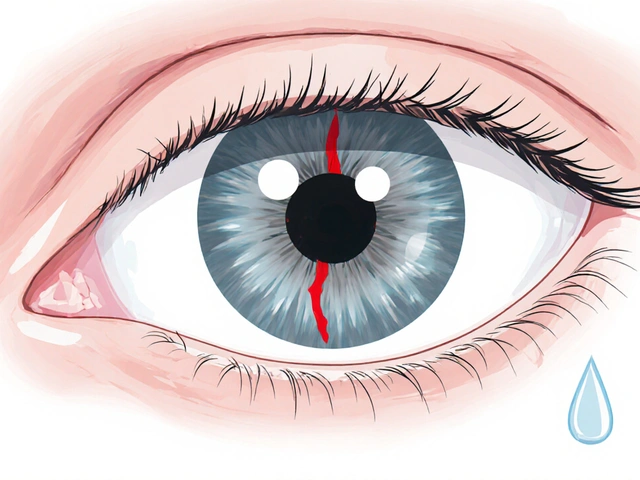Linezolid is an oxazolidinone antibiotic that blocks bacterial protein synthesis by binding to the 50S ribosomal subunit, approved for serious Gram‑positive infections such as those caused by Methicillin‑resistant Staphylococcus aureus (MRSA) and Vancomycin‑resistant Enterococcus (VRE). When used correctly, it delivers rapid bacterial clearance with a convenient twice‑daily schedule.
Understanding the Pharmacology
Linezolid belongs to the oxazolidinone class, a newer family of antibiotics that differ from beta‑lactams and glycopeptides. Its oral bioavailability exceeds 90%, meaning the oral dose achieves almost the same plasma levels as the intravenous formulation. This property makes it ideal for early switch therapy, reducing hospital stay and catheter‑related complications.
Dosing Fundamentals
Standard adult dosing is 600mg every 12hours, either IV or oral. For pediatric patients (≥12kg), the dose is 10mg/kg every 12hours, not to exceed the adult total. Renal impairment alone does not require dose reduction because linezolid is primarily metabolized in the liver, but severe hepatic dysfunction (Child‑Pugh C) may warrant a 20‑30% reduction and closer monitoring.
- Confirm patient weight and calculate dose if pediatric.
- Check liver function tests (ALT, AST, bilirubin) before starting.
- For IV administration, dilute 600mg in 100mL of compatible fluid and infuse over 30‑60minutes.
- Consider oral switch once the patient tolerates oral intake and is clinically stable.
Therapeutic Drug Monitoring and Laboratory Checks
While routine plasma level testing is not mandatory, certain situations benefit from therapeutic drug monitoring (TDM): prolonged therapy (>14 days), renal or hepatic failure, and concomitant drugs that affect linezolid clearance. Target trough concentrations are generally 2‑7µg/mL; values above 10µg/mL increase the risk of thrombocytopenia.
- Baseline complete blood count (CBC) - focus on platelets.
- Baseline renal panel - serum creatinine, eGFR.
- Baseline liver panel - ALT, AST, alkaline phosphatase, bilirubin.
- Repeat CBC twice weekly for the first two weeks, then weekly.
- Check visual acuity if therapy exceeds three weeks.
Managing Common Adverse Effects
Thrombocytopenia is the most frequent hematologic toxicity, typically emerging after 7‑10 days. If platelets fall below 50×10⁹/L, consider dose interruption or switch to an alternative agent. Peripheral neuropathy and optic neuropathy are rarer but may become irreversible after prolonged exposure; patients should report any new numbness, tingling, or visual changes promptly.
A less obvious reaction is serotonin syndrome, caused by concurrent use of serotonergic drugs (SSRIs, SNRIs, tricyclics, linezolid’s MAO‑inhibitory activity). Symptoms range from mild agitation to life‑threatening hyperthermia and muscle rigidity. If suspected, stop linezolid immediately and treat according to standard serotonin‑syndrome protocols.

Drug‑Interaction Checklist
Because linezolid inhibits monoamine oxidase, it interacts with several medication classes. Use the checklist below before starting therapy:
- Selective serotonin reuptake inhibitors (e.g., fluoxetine, sertraline)
- Serotonin‑norepinephrine reuptake inhibitors (e.g., venlafaxine, duloxetine)
- Tricyclic antidepressants (e.g., amitriptyline)
- Stimulants (e.g., methylphenidate)
- Linezolid with meperidine or tramadol - avoid due to additive MAO inhibition.
If any of these agents cannot be discontinued, consider an alternative antibiotic such as vancomycin or daptomycin, keeping in mind their own safety profiles.
Practical Administration Tips
For a smooth linezolid administration process, keep these points in mind:
- Always verify the formulation (IV vs oral) and ensure the right concentration before infusion.
- Infuse IV doses over at least 30minutes; faster rates increase risk of hypotension and infusion‑site discomfort.
- Document the exact time of each dose; missed doses should be given as soon as remembered unless >6hours have passed.
- Educate patients on the importance of adherence, especially when transitioning to oral therapy.
- Store the drug at room temperature, away from moisture; do not refrigerate oral tablets.
When to Adjust or Avoid Linezolid
Although linezolid is generally safe, certain clinical scenarios demand caution:
- Severe hepatic impairment - reduce dose and monitor TDM.
- Pregnancy - category C; weigh maternal benefits against potential fetal risk.
- Concurrent MAO inhibitors - absolute contraindication.
- History of serotonin syndrome - avoid or choose an alternative.
In these cases, discuss alternative agents with the infectious‑disease team, considering local susceptibility patterns.
Quick Reference: TL;DR
- Standard dose: 600mg q12h (IV or oral); pediatric 10mg/kg q12h.
- Check CBC, liver, renal labs before and during therapy.
- Watch for thrombocytopenia after day7; stop if platelets <50×10⁹/L.
- Avoid serotonergic drugs; monitor for serotonin syndrome.
- Switch to oral as soon as the patient can tolerate; this cuts costs and line‑related risks.
| Attribute | Linezolid | Vancomycin | Daptomycin |
|---|---|---|---|
| Mechanism | Protein synthesis inhibition (50S) | Cell‑wall synthesis inhibition | Membrane depolarization |
| Typical Route | IV or oral (high bioavailability) | IV only | IV only |
| Dosing Frequency | Every 12h | Every 12h (continuous infusion possible) | Every 24h |
| Renal Consideration | No dose adjustment needed | Dose adjustment required | Dose adjustment required |
| Thrombocytopenia Risk | Moderate (incidence ~10%) | Low | Low |
| Serotonin Syndrome | Yes (MAO inhibition) | No | No |

Frequently Asked Questions
What is the usual duration of linezolid therapy?
The typical course lasts 10‑14days for most skin and soft‑tissue infections. For more complex infections like osteomyelitis, treatment may extend to 6weeks based on clinical response and microbiology results.
Can linezolid be given to patients on dialysis?
Yes. Since linezolid is not cleared by the kidneys, no dose reduction is needed for hemodialysis or peritoneal dialysis patients. However, monitor for hematologic toxicity, which may be more pronounced in this population.
How should I handle a missed linezolid dose?
If the dose is remembered within 6hours, give it as soon as possible and continue the regular schedule. If more than 6hours have passed, skip the missed dose and resume the next scheduled dose to avoid double‑dosing.
Is it safe to use linezolid with SSRIs?
Co‑administration poses a risk of serotonin syndrome. If the SSRI cannot be stopped, consider an alternative antibiotic. If both must be used, monitor closely for agitation, tremor, hyperreflexia, or fever, and be ready to discontinue linezolid immediately.
What lab abnormalities signal that linezolid should be stopped?
A platelet count dropping below 50×10⁹/L, a rise in serum bilirubin >3×baseline, or a sudden rise in ALT/AST >5×ULN warrants discontinuation. Early detection through twice‑weekly CBCs and weekly liver panels is essential.
When is oral linezolid preferred over IV?
As soon as the patient can tolerate oral intake, has a functioning gastrointestinal tract, and shows clinical stability, switching to oral 600mg q12h reduces catheter‑related infections, shortens hospital stay, and cuts costs while maintaining efficacy.




Comments
5 Comments
Stacy Natanielle
Just saw this and had to chime in - linezolid is a beast when you need it, but that thrombocytopenia window? 😳 7–10 days is such a sneaky timeline. I’ve seen patients flatline platelets right after they’re discharged because no one told them to get a CBC on day 9. Please, for the love of all that’s holy, put a sticky note on their discharge summary: ‘Check platelets in 7 days.’ 🩸📉 #PharmToxLife
kelly mckeown
i just wanted to say thank you for writing this. i’m a nurse in a small rural hospital and we don’t always have infectious disease support, so posts like this make me feel less alone. i’ve had to switch a few patients to oral linezolid and honestly, the difference in their mood once they’re out of the iv pole is huge. they feel more like themselves. also, i always forget to check visual acuity until week 3… now i have a calendar alert. 🙏
Tom Costello
Excellent breakdown. One thing I’d add from my time in the ICU: the serotonin syndrome risk is underappreciated. I had a patient on sertraline who got linezolid for a complicated pneumonia. By hour 12, he was hypertensive, diaphoretic, and clenching his jaw like he was trying to bite through steel. We stopped linezolid, gave cyproheptadine, and he bounced back. But if we hadn’t caught it early? Catastrophe. Always ask about antidepressants - even if the patient says ‘I’m fine on them.’ They rarely volunteer that info.
Also, oral switch timing? Don’t wait for them to be ‘fully stable.’ If they’re tolerating crackers and water and their fever’s down, go ahead. The bioavailability is near perfect. Save the IV for the septic shock cases.
dylan dowsett
Wait - you’re telling me you’re giving linezolid to someone on duloxetine??!!?? That’s not just risky - that’s negligent. I’ve seen two patients die from serotonin syndrome because someone ‘thought it was fine.’ If you’re not going to stop the SSRI, don’t touch linezolid. Period. End of story. There are alternatives. Vancomycin isn’t perfect, but it doesn’t turn your brain into a fireworks show. And don’t even get me started on the optic neuropathy - irreversible blindness after 4 weeks? You think you’re saving money? You’re just creating a lifetime of disability claims. This drug needs a warning label the size of a billboard.
Susan Haboustak
Actually, the TL;DR is wrong - it says ‘stop if platelets 3×baseline’ - that’s not right. You stop if platelets drop below 50×10⁹/L OR if they fall by 50% from baseline - not 3x. That typo could kill someone. Also, you mention ‘sudden rise in ALT/AST >5×ULN warrants discontinuation’ - that’s not in the FDA label. That’s an institutional guideline. Please fix this. I’ve seen residents misinterpret this exact line and stop linezolid unnecessarily, leading to treatment failure. Accuracy matters.
Write a comment